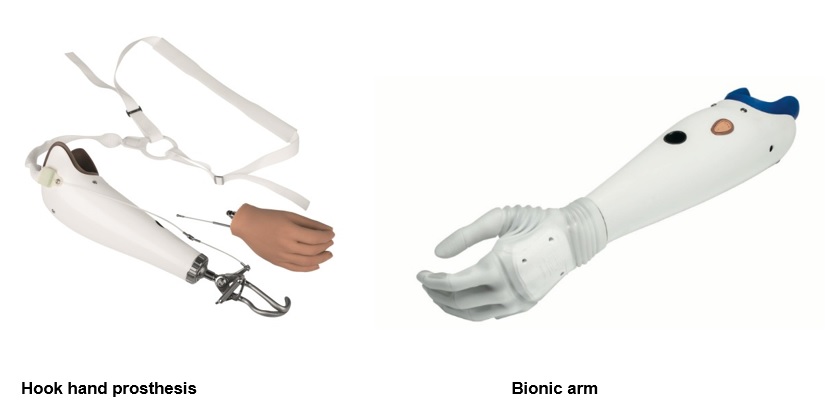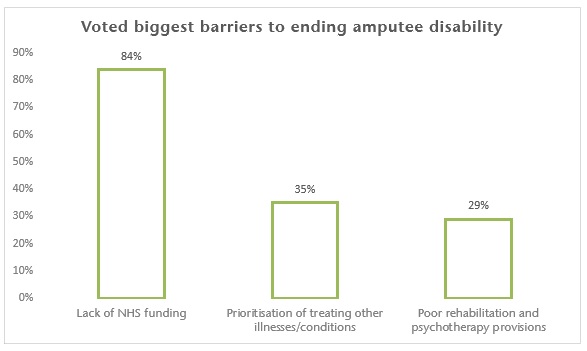The public perception of amputee disability
- 13.07.2018
- EmmaArnold
- None
Through our work with amputees, we’ve developed a very detailed understanding of different prosthetic technologies and the benefits and issues associated with them; but one of the key focuses of this campaign was to understand the public’s thoughts on the matter.
We recently ran a survey to gauge those thoughts and, thanks to the hundreds of people who participated, we’ve gleaned some incredibly interesting insights.
Respondents shared their views on the cost and benefits of prosthetic development as well as when they would consider a prosthetic user to be disabled. Here, we have compiled the key themes to share the public perception of amputee disability.
Benefits outweighing costs
We asked the public whether they thought the benefits of different prosthesis outweighed their cost to the NHS.
We included a range of prosthetic limbs, from a basic-level hook hand mechanism that can cost between £7,000 and £10,000 - to a state-of-the-art bionic arm costing more than £70,000.

On average, 83% of respondents believed that the benefits of these different prosthetics outweighed the costs. They said that the improvement to the amputee’s quality of life and the increased level of independence that they offered was greater than the cost to the NHS. One respondent said:
My son wears a prosthetic eye and I know that looking more ‘normal’ has contributed to his mental well-being, so I think the same would be the case with this prosthetic.
The remaining 17% of respondents who did not think that the benefits outweighed the costs cited reasons such as the basic look and functionality of some of the prosthetics. Another respondent said:
Advancements in technology mean that better prosthesis should be available, even though more expensive, they would allow an amputee to be more independent. These prosthesis look cumbersome.
Despite the majority of people agreeing that the costs are justified overall, respondents were less likely to think the benefits of more expensive prosthesis outweighed the cost, despite them being much more advanced. For example, 91% of respondents said the benefits of the hook hand prosthetic outweighed the £7,000 - £10,000 cost, but only 68% of respondents said the same for the +£70,000 bionic arm.
Ending amputee disability
Prosthesis development has soared in recent years, helping to improving the independence of many amputees and enabling them to live a fuller life - but it seems that we are still a while away from ending amputee disability.
We asked the public whether they considered someone using different prosthesis as disabled, and 74% said ‘yes’. Additionally, 70% of respondents said that they would class someone using the most advanced prosthetic arm as disabled, which was only an 8% decrease on the number of people who deemed someone using the most basic prosthetic to be disabled.
Despite this, 44% of respondents still thought that an amputee athlete wearing a prosthetic blade would beat an able bodied athlete in a 200m race, assuming both had an identical level of cardiovascular fitness.
On top of this, only 16% of respondents said they thought we could end amputee disability with the technology that is currently available via the NHS; another 35% said that we cannot, and the majority (49%) said they were unsure.
Barriers holding us back
Although there have been many advancements to prosthetic technology, amputees face a number of challenges to secure and effectively operate modern prosthesis.
We previously spoke to some experts about these barriers and, within our survey, we asked the public what they thought was holding us back from ending amputee disability. Across all respondents, the three biggest barriers to ending amputee disability were:

The fourth biggest barrier overall was ‘technology not being advanced enough’ - but interestingly, when we looked at how people of different genders responded to this question, this barrier was actually ranked as the third biggest by men, and fifth by women. Instead, women ranked ‘issues with user adaptation/adoption’ as the fourth biggest barrier.
Next in the series
As we near the end of the series, we will summarise our findings and share the opinions of one of Potter Rees Dolan’s experts in this realm.
